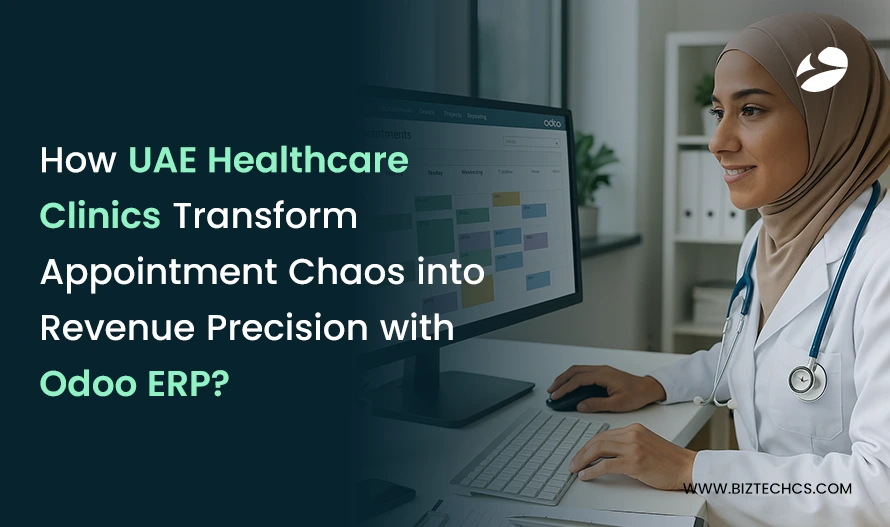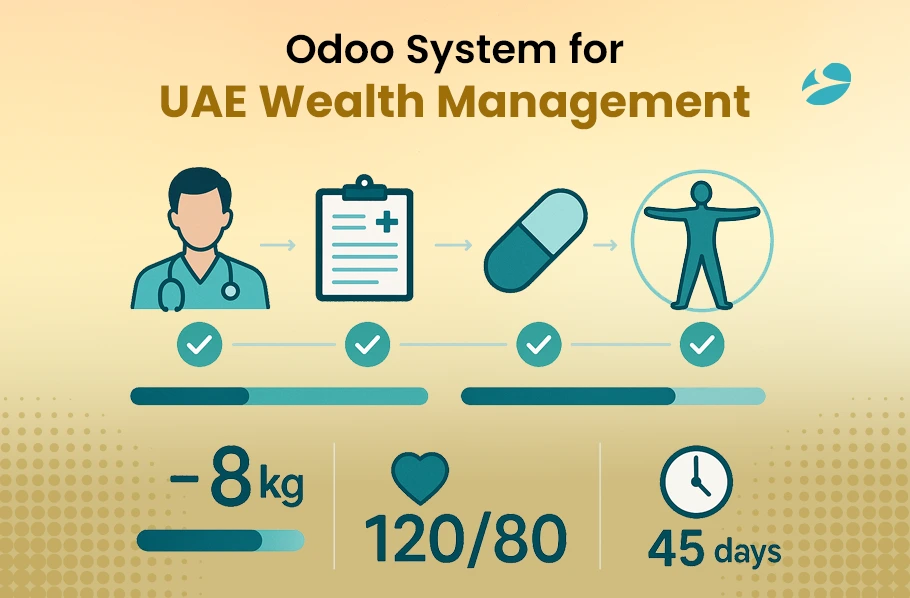88
How UAE Healthcare Clinics Transform Appointment Chaos into Revenue Precision with Odoo ERP?
28 Jul, 2025
5 min read
88
28 Jul, 2025
5 min read
Table of Content

Your dermatology clinic in Dubai Marina is thriving. Over 200 patients walk through the doors each week, appointments are fully booked for months, and every treatment chair is in constant use from 8 AM to 8 PM. On the surface, everything looks ideal. But when the CFO asks, “What’s our actual revenue per doctor this quarter?”—no one has a clear answer.
This isn’t uncommon. The global healthcare ERP market size was estimated at USD 7.42 billion in 2023 and is expected to grow at a CAGR of 7.2% from 2024 to 2030, driven largely by healthcare providers struggling with the same fundamental challenge: disconnected systems that blur financial visibility.
In the UAE’s rapidly digitizing healthcare landscape, where the digital health market size was estimated at USD 619.3 million in 2023 and is expected to grow at a CAGR of 23.3% from 2024 to 2030, clinics can no longer afford to operate with appointment systems divorced from their financial reality.
Have you ever wondered why your busiest days don’t always translate to your most profitable ones through effective business process automation?
Dr. Sarah Al-Mansouri runs a multi-specialty clinic chain across Dubai and Sharjah, managing complex business processes through traditional methods. Her reception team manages over 500 weekly appointments through a third-party booking platform. Doctors maintain patient notes in Word files. Treatment pricing happens manually at checkout. Invoice generation takes 2-3 days after procedures.
In similar leadership discussions, we often ask a foundational question: “Can your clinic pull revenue per doctor per day—accurately and in real time?”
More often than not, this question reveals a major visibility gap. Despite full appointment calendars, many clinics still struggle to answer fundamental financial performance questions:
💡 ERP Consultant Tip: In the UAE healthcare sector, always start with mapping the appointment-to-invoice flow through comprehensive business process automation. Medical revenue is time-sensitive and audit-visible—disconnected systems create operational risks and cash flow delays.
In such situations, transformation typically starts by connecting the dots between appointments, patient records, and billing. With Odoo, we can configure workflows to automatically capture key booking details—such as consulting doctor, service type, location, and insurance status—without relying on manual processes or disconnected platforms.
The immediate wins were striking:
These early improvements didn’t just reduce admin load—they unlocked real-time visibility across the clinic. One morning, when the Medical Director asked, “Can I see all consultations pending payment today?” reception was able to pull up a live dashboard within seconds. Visits were filtered by urgency, payment type, and location, providing the team with a clear and actionable view of outstanding revenue.
Soon after, the CFO raised a more profound concern: with three insurance networks operating across multiple branches, could the system automatically apply each insurer’s specific coverage rules?
In scenarios involving multiple insurance providers like ADNIC, Oman Insurance, or Dubai Insurance, we can configure dynamic insurance logic within Odoo. This ensures that co-pay rules, coverage tiers, and pre-authorization requirements are automatically applied, reducing billing friction and manual intervention. That meant no more last-minute calls, no more manual checks, and no surprises in the billing cycle.
One crucial takeaway emerged early: Scheduling workflows must reflect how care is delivered. If a doctor’s calendar and the billing engine aren’t aligned, data gaps form that impact everything from revenue tracking to patient experience. That’s why BiztechCS designed the entire appointment layer to sync natively with clinical and financial processes, right from the start.
For clinics exploring digital transformation, the most effective first step is often a single-location pilot. It allows teams to validate appointment-to-revenue logic in a real-world setting before scaling across the network.

The second phase focused on aligning the clinic’s billing process with UAE-specific VAT regulations while simplifying complex pricing structures through digital transformation. BiztechCS introduced standardized procedure bundles, including consultations with skin analysis, injectable treatments with numbing cream, and laser procedures paired with aftercare products. Each bundle was digitally mapped to precise, VAT-compliant pricing using automated business workflows.
Invoices are now auto-generated at the point of service, with intelligent appointment scheduling feeding into real-time billing. Given the UAE’s nuanced VAT rules—where essential healthcare is exempt and elective cosmetic treatments are subject to a standard 5% VAT—clarity and compliance are crucial.
Naturally, this raised questions from the clinic’s operations team. One manager asked, “How do we ensure cosmetic treatments are taxed appropriately, while medical procedures remain exempt? Are we applying flat VAT rates across the board?”
BiztechCS addressed this through pre-configured service catalogs, which were explicitly built for the UAE’s VAT framework. Medical consultations, diagnostics, and essential treatments are automatically exempt from VAT. Meanwhile, aesthetic procedures such as Botox and laser hair removal, as well as other non-medical services, are billed with the standard 5% VAT. This setup minimizes human error and ensures full compliance, even during audits.
ERP Integration Highlights:
A key takeaway for clinics in the region: Configure VAT exemptions at the service level, not the invoice level. This ensures clean audit trails and avoids complications during regulatory reviews.
In the final phase of a revenue visibility transformation, we focus on turning scattered financial data into actionable insights. With Odoo, we can implement doctor-specific payout logic, customized to match real-world operations, whether it’s fixed compensation, commission-based models, or a hybrid approach.
Weekly performance reports now showed:
The CFO summed it up best: “I finally trust the numbers. Every procedure, every dirham is traceable from appointment booking to bank deposit.”
During a strategy session, the medical director asked, “Can we also track follow-up appointment compliance and link it to treatment outcomes for quality reporting?”
The answer: Absolutely. BiztechCS’s advanced healthcare dashboards monitor the entire patient journey—from first consultation to final follow-up. Our custom Odoo development integrates appointment data with satisfaction scores and treatment outcomes, allowing your clinic to identify which services require stronger follow-up care and which doctors consistently achieve high patient retention rates. That kind of insight is not just valuable for internal benchmarking—it’s essential for meeting the standards of the UAE healthcare authority and negotiating with insurance networks.
Planning a multi-branch expansion? We’ll help map your clinical workflows to UAE compliance requirements before the first line of code is written.
85% of businesses that hired software consultants for ERP implementation achieved success rates, but BiztechCS’s healthcare-focused Odoo ERP approach delivered results faster than industry averages through our proven Odoo development expertise:
Week 1-2: Foundation Setup
Week 3-4: Service Bundle Configuration
Week 5-6: Analytics and Performance Tracking
Final Results After 45 Days:

The transformation hasn’t happened in isolation. Healthcare spending in the UAE accounts for 5% of GDP and is expected to rise to 5.4% by 2024, growing at a CAGR of 8.5%. With this growth comes mounting pressure on healthcare providers—not just to deliver exceptional care, but to demonstrate financial efficiency and regulatory compliance as part of broader digital transformation efforts.
What makes UAE healthcare ERP implementations unique?
Healthcare ERP implementations in the UAE are more successful when approached in phases. A common pitfall is jumping into clinical module automation too early. A better approach? Start with revenue cycle management. UAE healthcare providers often need financial clarity first—clinical efficiency naturally follows once the numbers make sense.
That’s why many administrators ask: “Our current booking system handles online scheduling well—can we integrate it with Odoo rather than replace it entirely?”
Absolutely. At BiztechCS, we specialize in API integrations that enable clinics to maintain their existing patient booking workflows while seamlessly integrating with Odoo’s financial and compliance modules.
Most UAE clinics prefer this hybrid setup—it preserves familiar patient-facing systems, such as Vezeeta, Okadoc, or custom-built platforms, while layering in the backend intelligence needed to drive smarter decisions, ensure regulatory compliance, and promote revenue transparency.
Dr. Al-Mansouri’s clinic transformation illustrates a broader trend. Modern healthcare ERP isn’t just about appointment scheduling—it’s about creating financial intelligence that scales with clinical excellence.
Strategic Advantages Realized:
Data-Driven Decision Making
Regulatory Foundation
Scalable Growth Foundation
Considering ERP modernization but concerned about disrupting patient care during implementation? BiztechCS specializes in phased healthcare rollouts that maintain clinical operations throughout the transition.
Here’s how we structure Odoo ERP to meet the unique operational and regulatory needs of UAE healthcare clinics.
Appointments + CRM: Patient lifecycle management from initial contact through follow-up care scheduling
Invoicing + Accounting: Real-time VAT-aligned billing with insurance claim integration and multi-currency support
Inventory Management: Medical supply tracking with expiration date monitoring and automatic reorder triggers
HR + Payroll: Doctor compensation tracking tied to completed appointments and performance metrics
Reporting + Analytics: Custom dashboards for clinical, financial, and operational KPIs with UAE regulatory reporting structure
Healthcare Odoo configurations require careful sequencing of modules. Start with patient data migration, then configure service catalogs, and finally activate automated billing workflows. This prevents data inconsistencies during go-live.
Challenge 1: Insurance Network Complexity
UAE clinics deal with 20+ insurance providers, each with different coverage rules, pre-authorization requirements, and claim submission formats.
BiztechCS Solution: Built dynamic insurance validation with real-time eligibility checking and automated claim formatting based on provider requirements.
Challenge 2: Multi-Language Patient Communication
The patient base speaks Arabic, English, Hindi, and other languages requiring documentation and billing in multiple formats.
BiztechCS Solution:
Configured multi-language invoice templates and appointment confirmations with automatic language detection based on patient preferences.
Challenge 3: Doctor Schedule Optimization
Specialists work across multiple locations with varying availability, making appointment scheduling and revenue allocation complex.
BiztechCS Solution: Developed location-aware scheduling with automatic revenue attribution and resource optimization across the clinic network.
Challenge 4: Real-Time Mobility for Doctors
Doctors often consult using iPads or mobile devices, requiring instant updates to patient records and billing workflows.
BiztechCS Solution:
Enabled mobile-optimized Odoo interfaces that work seamlessly on iPads and smartphones. Doctors can update patient records, complete treatments, and trigger billing in real-time—ensuring reception staff see invoicing prompts the moment a consultation ends.
Predictive Analytics Integration BiztechCS configured appointment trend analysis to predict optimal staffing levels, inventory needs, and revenue forecasting. The system now identifies:
Treatment Outcome Tracking Connected patient satisfaction scores to billing completion rates, revealing that patients who received immediate, clear invoices showed 23% higher satisfaction ratings and 31% better follow-up appointment compliance.
Multi-Channel Patient Engagement Integrated appointment confirmations, payment reminders, and follow-up care instructions through SMS, email, and WhatsApp—all triggered automatically based on patient preferences and appointment status.
Exploring advanced healthcare analytics to predict patient trends and optimize resource allocation? Let’s discuss how UAE compliance requirements shape predictive modeling approaches.
According to a 2024 healthcare technology report, more than 50% of healthcare organizations plan to upgrade their ERP systems to improve financial transparency and streamline billing workflows. UAE healthcare providers who implement comprehensive Odoo ERP solutions now gain first-mover advantages in business process automation:
Market Positioning Benefits:
Operational Excellence:
Dr. Al-Mansouri’s success story represents more than operational improvement—it demonstrates how healthcare ERP becomes a strategic infrastructure for sustainable growth. As the UAE healthcare market matures and patient expectations rise, clinics with integrated, intelligent ERP foundations will capture a disproportionate market share.
Future-Proofing Elements:
The Bottom Line for UAE Healthcare Leaders
Every appointment represents potential revenue—but only if your systems can capture, process, and track that value effectively. BiztechCS transforms healthcare appointment chaos into revenue precision by building ERP foundations that scale with clinical excellence.
A: Our phased approach typically delivers results in 45-90 days. Phase 1 (appointment integration) takes 2-3 weeks, Phase 2 (billing automation) requires 3-4 weeks, and Phase 3 (analytics dashboards) completes in 2-3 weeks. We maintain clinic operations throughout the entire process.
A: Absolutely. BiztechCS specializes in API integrations that preserve your current patient-facing booking workflows while connecting them to Odoo’s financial backend. We’ve successfully integrated with Vezeeta, Okadoc, and custom booking platforms across UAE healthcare facilities.
A: Our Odoo development includes dynamic insurance validation that automatically applies coverage rules, co-payment amounts, and pre-authorization requirements for each patient’s specific insurance provider. The system maintains real-time connections with major UAE networks including ADNIC, Oman Insurance, and Dubai Insurance.
A: Yes. Our healthcare Odoo configuration includes mobile-optimized interfaces that work seamlessly on iPads and smartphones. Doctors can update patient records, mark treatments as completed, and trigger automatic billing in real-time during appointments.
All product and company names are trademarks™, registered® or copyright© trademarks of their respective holders. Use of them does not imply any affiliation with or endorsement by them.

68
By Biztech
09 Oct, 2025

74
By Biztech
09 Oct, 2025

91
By Biztech
06 Oct, 2025